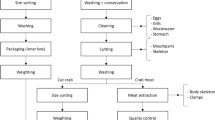Abstract
The quality of feed, including its microbiological characteristics, is important for the organization of full-value feeding of animals in agriculture. So, the means of non-reagent processing of feeds, including cavitation treatment, are becoming more widespread. In our study, it was shown that the amount of mesophilic aerobic and facultative anaerobic microorganisms (QMAFAnM) decreases after a 5-min treatment of the test samples (chalk, fuz, bran, and zeolite) (1.1–35 times) compared to untreated samples, while an increase in the duration of exposure is proportional to the expression of the bactericidal effect. A study of the bioluminescent response of the test strain Escherichia coli K12 TG1 under the influence of the test samples showed inhibition of bioluminescence under the action of chalk and an increase in luminescence during incubation with fusa and bran. When examining the growth rates of strains E. Coli 675 and Bifidobacterium longum B379M, it was found that water and zeolite treated with cavitation suppressed the growth of E. coli 675, while the growth of Bifidobacterium longum B379M was higher than the control values at the end of the experiment. So, cavitation processing can cause the death of microflora of feed additives, at the same time, as a result of the dissociation of a complex of organic polymers, contributing to the positive response of probiotic strains. These studies can be used in agriculture in the preparation of feed additives from waste from the processing industry.


Similar content being viewed by others
References
Aniskevich ON (2013) Change in the technological properties of water during sonication processing. Food industry: Sci Tech 2:44–49 (In Russian)
Bakach NG et al (2017) Perspective technology and equipment for the preparation of full-fledged easily digestible forage for young cattle. Vestnik Sci Res Inst Mech Anim Husbandry 2(26):1–7 (In Russian)
Belyaev AN, Flegentov IV, Suslov AS (2012) Perfection of industrial technologies for water disinfection // Natural-anthropogenic landscape complexes of the steppe zone of the Chechen Republic 1:21 (In Russian)
Bykov AV et al (2011) Prospects for the use of cavitation hydrolysis of non-starch polysaccharides // Bulletin of the Orenburg State University 4 (123):12–16 (In Russian)
Deryabin DG et al (2013) Investigation of the mechanisms of antibacterial activity of copper nanoparticles in tests on luminescent strains of Escherichia coli. Nanotech Russ 8(5–6):113–118
Kirnos IO et al (2011) Adaptive feeding system is the decisive factor in the realization of the genetic potential of cow productivity. Zootechny 9:9–11 (In Russian)
Lee K et al (2017) Prevalence of foodborne pathogens in pigs and cattle carcass samples collected from Korean slaughterhouses. Int J Anim Vet Sci 4(12):1–10
Petrova OG, Barashkin MI, Makarimov AS (2013) Causes of diseases of highly productive cows. Agr Herald Urals 1:28–30 (In Russian)
Robinson TP, Wertheim HF, Kakkar M, Kariuki S, Bu D, Price LB (2016) Animal production and antimicrobial resistance in the clinic. Lancet 387(10014):e1–e3
Šarc A, Kosel J, Stopar D, Oder M, Dular M (2018) Removal of bacteria Legionella pneumophila, Escherichia coli, and Bacillus subtilis by (super) cavitation. Ultrason Sonochem 42:228–236
Sell-Kubiak E, Wimmers K, Reyer H, Szwaczkowski T (2017) Genetic aspects of feed efficiency and reduction in environmental footprints in journals: a review. J Appl Genet 58(4):487–498
Shvanskaya IA, Konovalenko LY (2011) The use of waste processing industries in livestock: scientific. analyte. overview. FGBNU “Rosinformagrotekh”, Moscow
Wu F et al (2017) Research progress of applications of ultrasonic technology in the food industry. J Food Saf Qual 8(7):2670–2677
Yankovsky DS, Dyment GS (2006) Bifidobacteria and lactobacilli as the optimal basis for modern probiotics. Modern Ped 3(12):1–10
Yasuda J, Miyashita T, Taguchi K, Yoshizawa S, Umemura SI (2015) Quantitative assessment of reactive oxygen sonochemically generated by cavitation bubbles. Jpn J Appl Phys 54(7S1):07HF21
Zhang Y, Zhang Y, Qian Z, Ji B, Wu Y (2016) A review of microscopic interactions between cavitation bubbles and particles in silt-laden flow. Renew Sust Energ Rev 56:303–318
Funding
This research was carried out with the financial support of the Russian Ministry of Science and Education as part of the base part of the state task to carry out research projects in the Orenburg State University (No. 6.6811.2017/Ch).
Author information
Authors and Affiliations
Corresponding author
Additional information
Responsible editor: Philippe Garrigues
Rights and permissions
About this article
Cite this article
Bykov, A., Kvan, O., Gavrish, I. et al. Cavitation treatment as a means of modifying the antibacterial activity of various feed additives. Environ Sci Pollut Res 26, 2845–2850 (2019). https://doi.org/10.1007/s11356-018-3828-7
Received:
Accepted:
Published:
Issue Date:
DOI: https://doi.org/10.1007/s11356-018-3828-7




